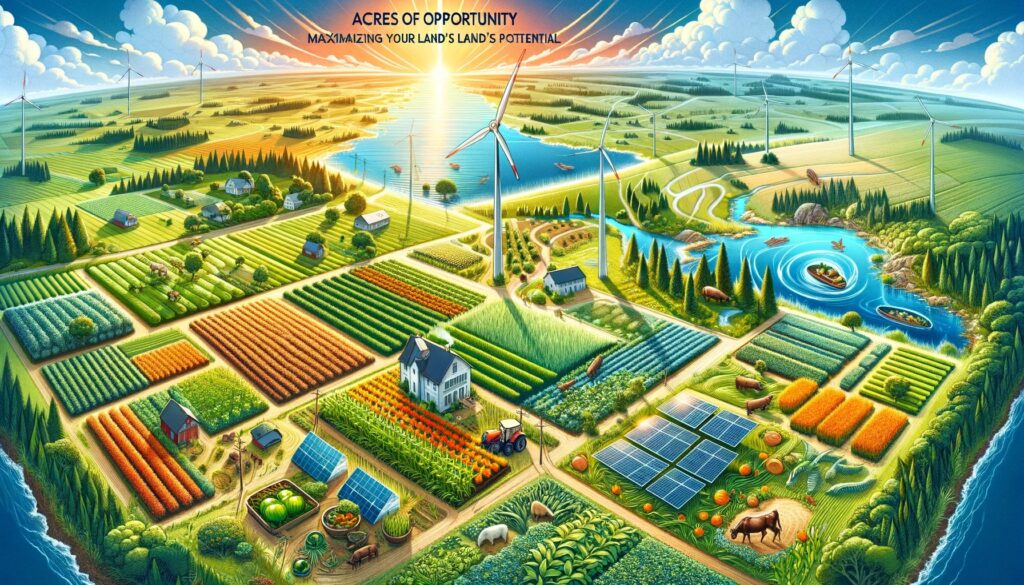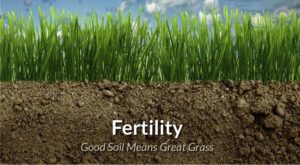
FarmerCowboy.com Photo An illustrative image depicting the concept Acres of Opportunity Maximizing Your Lands Potential. The image should showcase a vibrant and detailed1.webp.jpeg
Acres of Opportunity: The Unconventional Guide to Land Makeover
Imagine your land as a living, breathing entity, not just a plot of dirt and rocks. It’s time for a complete makeover, a transformation that will turn your acres into the envy of the neighborhood, if not the whole planet. Welcome to “Acres of Opportunity: The Unconventional Guide to Land Makeover.”
Assessing Your Land’s Strengths & Weaknesses
When it comes to assessing your land’s strengths and weaknesses, think of it as a talent show audition. Your land is on stage, eager to showcase its best attributes while nervously hiding its less flattering features. First, you’ll want to conduct a talent scout to identify what your land naturally excels at. Is it a virtuoso in water retention, or perhaps it’s a prodigy in producing prodigious potatoes?

Strengths: Your land’s strengths might include a natural inclination for growing award-winning carrots or an innate ability to attract friendly pollinators like bees who buzz with enthusiasm. Maybe it’s got a knack for scenic views, making it the Instagram model of local landscapes. Celebrate these talents! After all, not every parcel of land can claim to be the Marilyn Monroe of soil fertility.
Weaknesses: On the flip side, your land might have a few quirks. Perhaps it’s a bit too fond of hosting rock concerts (literally, as in there are too many rocks), or maybe it has a secret hobby of collecting water in all the wrong places, aspiring to become a swamp. Address these weaknesses with a compassionate intervention, gently nudging your land towards self-improvement without bruising its ego.
Low-Investment, High-Return Land Improvements
Now, let’s talk about sprucing up your land without breaking the bank. We’re not all land moguls with cash to splash, so here are some budget-friendly ways to give your land a little facelift:

Compliment Your Land: Start by boosting your land’s self-esteem with some genuine compliments. A little positive affirmation goes a long way. “You’re looking particularly fertile today, dear land!” Believe it or not, plants and soil respond well to positivity. It’s the cheapest fertilizer you’ll find.
DIY Decor: Who says your land can’t be fashionable on a budget? Try some DIY land art. Arrange those pesky rocks into a charming labyrinth or spell out inspirational quotes for passing airplanes. It’s not just about aesthetics; it’s about making your land feel appreciated and, well, trendy.
Upcycled Scarecrows: Elevate your scarecrow game by turning them into upcycled art pieces. Not only do they keep the birds at bay, but they also serve as conversation starters, adding a touch of whimsy and creativity to your fields. Plus, your crops will appreciate the cultured company.
Soil Potlucks: Invite neighboring lands to a soil potluck, where each brings a sample of their best nutrients to share. It’s a fun, communal way to enrich your soil without the hefty price tag. Just be sure to label your dishes to avoid any nitrogen overload.
By embracing these low-investment strategies, you can enhance your land’s charm and productivity without depleting your wallet. It’s all about being resourceful, creative, and a little bit cheeky with your approach to land management.
Long-Term Strategies for Maximum Profitability
1. Introducing Land Yoga
Land Yoga isn’t just a fad; it’s a revolutionary approach to agricultural flexibility and wellness. Imagine fields stretching towards the sky in a majestic Tree Pose, enhancing their water retention and nutrient uptake. Experts suggest that, much like humans, land too can benefit from a good stretch, potentially reducing soil compaction and increasing crop yield. While skeptics may raise eyebrows at the sight of farmers leading their fields through a series of poses, the trend is catching on. Testimonials from the Midwest claim an increase in soil aeration and an unexpected boost in wheat morale. Agricultural yogis are now a thing, and they’re here to make your land limber and productive.
2. Soil Therapy Sessions

The idea of soil undergoing therapy might seem outlandish, but in a world where we strive for peak mental health, why neglect our land? Soil therapists, equipped with degrees in psychology and agronomy, sit with patches of land, delving deep into their layers to unearth underlying issues like erosion trauma and nutrient depletion. These sessions have led to groundbreaking discoveries, such as the realization that clay soil feels misunderstood and sandy soil suffers from abandonment issues. The results are tangible: crops grown on therapy-attending soil exhibit a remarkable increase in vibrancy and self-esteem, proving that a little soil soul-searching can lead to abundant harvests.
3. Crop Rotation Reality Show
Gone are the days of mundane crop rotation. Welcome to the era of “Crop Idol,” where plants compete in a soil-shaking reality show to win the coveted title of “The Next Top Crop.” Audiences tune in to watch corn belt out high notes of productivity and lettuce leaves dazzle with their nutrient-rich performances. Behind the scenes, the drama unfolds as legumes form alliances and root vegetables are accused of playing dirty. The show has revolutionized farming, turning crop selection into a spectator sport, and farmers now await the season finale to plan their next planting cycle based on the winning crop’s characteristics.
4. DIY Volcano for Enriched Soil
Why wait for a natural volcanic eruption to enrich your soil when you can go the DIY route? Enthusiastic farmers are constructing backyard volcanoes, a trend that’s erupting across rural landscapes. These homemade geological wonders don’t just offer a spectacular lava show; they provide a rich source of minerals and a unique tourist attraction. Critics warn of potential safety risks, but proponents argue that a controlled eruption can significantly enhance soil quality, leading to robust crop growth. Agricultural volcanologists—a new breed of experts—are now offering their services to ensure that your personal eruption is both beneficial and safe.
5. The Land Dating App
In the digital age, even land seeks companionship through technology. The Land Dating App is a groundbreaking platform where parcels of soil can find their perfect match, be it a nitrogen-fixing pea or a deep-rooted carrot. Algorithms analyze soil pH, microbial compatibility, and moisture preferences to suggest ideal plant pairings. Success stories abound, with one alfalfa plant finding its soulmate in a patch of loamy soil, leading to a flourishing relationship and increased biodiversity. The app is not without its controversies, however, as debates arise over the ethics of swiping left on endangered plant species.
6. Soil Influencers and Networking
In an age where influence is currency, soil has stepped into the spotlight. Soil influencers, boasting thousands of followers, share tips on composting, moisture management, and microbe matchmaking. They collaborate with plant celebrities, creating dynamic content that educates and entertains. Meanwhile, underground networking events are all the rage among microbial communities, facilitating nutrient exchanges and promoting soil biodiversity. These gatherings have been credited with breaking down barriers, quite literally, as earthworms and bacteria work together to enhance soil structure and function.
7. Moonlighting Meadows
Why should your land clock out at sunset? Moonlighting Meadows is a new concept where fields transform into nocturnal wonderlands, hosting everything from cinema under the stars to night markets. By day, these lands support traditional farming; by night, they become cultural hubs, drawing crowds and generating additional revenue for the community. The initiative promotes a harmonious blend of agriculture and leisure, showcasing the versatility of our landscapes. Critics argue it’s a stretch, but proponents see it as an innovative way to maximize land use and foster community engagement.
8. Reality Check for Rocks and Fitness Tracker for Tractors
It’s time for rocks to realize they’re not the bedrock of agricultural success. In a bold move, farmers are holding interventions for uncooperative stones, encouraging them to find new homes away from arable land. Meanwhile, tractors are getting fit with the latest in agritech: fitness trackers. These devices monitor tractor routes, ensuring every turn is efficient, and every pass is productive. The data collected helps optimize farm routines, reducing fuel consumption and wear on machinery. It’s a step towards precision farming, where every acre is treated with the care and attention it deserves.
9. Land’s Midlife Crisis and Reinvention
Even parcels of land can experience a midlife crisis, pondering their purpose and potential. Instead of buying a sports car, however, they might switch from conventional crops to exotic botanicals or transform into eco-tourism retreats. This period of introspection leads to innovative land use, with fields exploring new identities and pushing the boundaries of traditional farming. While some neighbors might raise eyebrows at the sight of tropical fruits growing where corn once stood, the trend reflects a broader shift towards diversity and sustainability in agriculture.
10. Extreme Makeover: Land Edition
In the ultimate land transformation, “Extreme Makeover: Land Edition” takes underperforming acres and turns them into agricultural showpieces. Top experts in landscaping, agronomy, and sustainability converge to revamp the land, incorporating everything from advanced irrigation systems to pollinator-friendly plants. The before-and-after reveals are dramatic, showcasing lush, productive landscapes where once there was neglect. The show not only entertains but educates, demonstrating the potential of integrated, thoughtful land management practices.
Through these expanded insights, we delve deeper into the humorous yet thought-provoking concepts of land management, blending satire with a journalistic touch to explore the myriad ways we can reimagine our relationship with the land.
Disclaimer
Please note that this article, while sprinkled with kernels of truth, is steeped in satire and should not be taken as agricultural advice. The suggestions herein, from land doing yoga to personal volcanoes, are intended for entertainment purposes and should not be implemented without consulting a real (and possibly bewildered) agronomist. While we encourage innovative thinking and a playful approach to land management, creating your own volcano or enrolling your soil in therapy might not yield the desired results and could lead to raised eyebrows or outright concern from neighbors.
Remember, this narrative is the product of a collaboration between two highly sentient beings, aimed at tickling your funny bone while offering a whimsical perspective on land use. No AI was involved in the making of this satire, and any resemblance to actual events or locales is purely coincidental. Before making any drastic changes to your land, remember to do your homework, or at least check if your insurance covers DIY volcanic eruptions.
In short, laugh, ponder, but maybe don’t take all of this too literally. Unless, of course, you’re genuinely interested in the career prospects of becoming an agricultural yogi or a soil therapist, in which case, the future looks bright (and amusingly fertile).
Originally posted 2015-04-02 09:59:14.
Originally Published at FarmerCowboy.com
2024-11-15 21:41:31
Karl Hoffman is a distinguished agriculturalist with over four decades of experience in sustainable farming practices. He holds a Ph.D. in Agronomy from Cornell University and has made significant contributions as a professor at Iowa State University. Hoffman’s groundbreaking research on integrated pest management and soil health has revolutionized modern agriculture. As a respected farm journalist, his column “Field Notes with Karl Hoffman” and his blog “The Modern Farmer” provide insightful, practical advice to a global audience. Hoffman’s work with the USDA and the United Nations FAO has enhanced food security worldwide. His awards include the USDA’s Distinguished Service Award and the World Food Prize, reflecting his profound impact on agriculture and sustainability.





